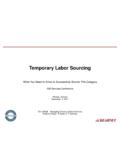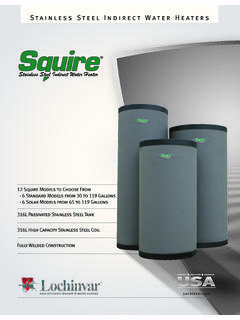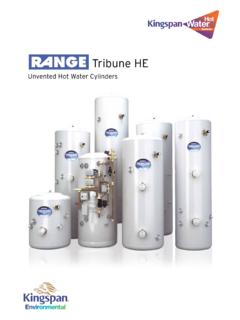Transcription of KPIs: Measuring Indirect Material Suppliers and …
1 kpis : Measuring Indirect Material Suppliers and Service Providers Karen M. Fedele, Category Manager The Gillette Company Tim Dolan, Manager, Strategic Sourcing and supplier Diversity 89th Annual International Supply Management Conference, April 2004 Abstract. Key Performance Indicators ( kpis ) have traditionally been used to measure and manage direct Material Suppliers . Direct materials, by their very nature, lend themselves more easily to kpis direct materials are more tangible and can be measured fairly easily. Supply chain professionals managing Indirect Material Suppliers and service providers are challenged with developing kpis that specifically address the differences associated with these Suppliers .
2 Fundamentally, the approach to measure and managing direct and Indirect Suppliers is the same; however, there are differences between direct and Indirect Suppliers . In order to effectively measure and manage Indirect Suppliers and service providers, a different set of kpis , one that factors both the objective and subjective nature of Indirect materials and services must be developed. Case for Measuring Indirect Suppliers . Indirect spend, as used in the context of this discussion, is defined as any purchased good or service that does not end up in the product or service delivered to a customer.
3 Direct spend is defined as a purchased good that is required to manufacture a finished good or a service that is provided to a customer. Companies have traditionally measured direct Suppliers performance as a way to control quality, reduce costs and ensure timely performance. As companies continue to expand the depth and breadth of supply chain management, it is becoming increasingly important to measure and manage Indirect Material and service Suppliers performance. And for good reason the average Indirect spend for a Fortune 500-size company is approximately 50% of its total spend.
4 Further, 5% annual growth is forecasted for Indirect spend over the next 5 years. It is imperative that Key Performance Indicators ( kpis ) are developed to measure and manage Indirect Suppliers performance. kpis calculate a supplier s value to the organization by comparing the supplier s performance against the company s requirements to the total cost of the goods and services purchased from the supplier . The purpose of kpis is to: Measure performance and improvement Manage supplier improvement efforts to your expectations and requirements Strengthen and improve supplier relations Develop Suppliers Reward for performance Justify the supplier s inclusion in your supply base Identify the need to re-source a supplier The end result is that kpis drive continuous improvement.
5 Since Procurement has traditionally managed direct spend, kpis have long been used to measure direct Suppliers performance. Developing evaluation criteria for direct Suppliers draws largely on objective data that can be measured, usually in the three traditional areas of priority: Price (total product cost) Delivery (performance to schedule) Quality (process variability and consistency) However, kpis can also be used to measure Indirect Suppliers performance too. The Process for Measuring Indirect Suppliers . Measuring Suppliers is a process of combining different measurements of quality into one single measurement of overall performance by assigning weighted values to each key element (or KPI) performed by the supplier and calculating a weighted score that can be used to track the supplier s performance.
6 Measuring Indirect Suppliers is more difficult due to a number of factors. Maverick spend is rampant and spend with Indirect Suppliers is often not captured in a company s data warehouse. Indirect goods and services are not subject to an incoming inspection, making quality measurement difficult, if not impossible. In some cases, delivery of Indirect goods and services is not captured within a company s ERP system. Criteria and metrics typically applied to direct Suppliers simply aren t always available for Indirect Suppliers . Despite these challenges, it is possible to develop kpis that measure Indirect supplier performance.
7 The first and most important step in beginning the process for Measuring Indirect Suppliers is to obtain management support of the initiative. Once management support is in place, it is necessary to determine which Suppliers will be measured and how frequently they will be measured. Criteria for supplier selection can be defined by a minimum amount of annual spend or critical supplier status. Determining how often to measure a supplier depends on your organization s industry and the type of supplier relationship. Measurement cycles range from 2 weeks to one year.
8 Establishing the list of kpis is the next step. This involves identifying the elements of an Indirect good or service. Once the key elements are defined, the next step is to determine which elements are indicators of supplier performance and then to identify a methodology for Measuring these elements. For example, Indirect Suppliers can be measured on criteria such as contract compliance, customer satisfaction, cost competitiveness and continuous improvement. Attributes for each category can be defined in the following way: Contract Compliance Actual cost versus budget How did the supplier perform against budget under or over the budgeted amount?
9 Performance against Service Level Agreement (SLA) or Statement of Work (SOW) How quickly does the supplier resolve issues relative to stated performance in an SLA or SOW? On-time deliveries (*if data is available) How quickly does the supplier deliver relative to their SLA or SOW? Return rate How many items are returned? How often? Order and Invoicing accuracy Am I receiving the product I order? Am I invoiced for the price quoted? Customer Satisfaction* Customer Service Technical Support *Usually obtained through customer surveys Cost Competitiveness supplier pricing versus industry averages supplier versus other benchmarks such as pricing quoted by another supplier Continuous Improvements supplier Partnership Initiatives Cost Reduction Targets Cost reduction recommendations submitted by the supplier (measured by the type and number of suggestions received, ideas implemented and cost savings produced)
10 Be careful of what you measure. What you measure gets done and drives the supplier s focus. The metrics don t have to be complicated, but they must be tightly defined and communicated to the Suppliers . Too many metrics result in a scorecard that is difficult to create and understand. Above all, the metrics selected must be controllable. supplier Score EXAMPLE Contract Compliance Customer Satisfaction Cost Competitiveness and Continuous Improvement Indirect supplier Evaluation Criteria Weight X Score = Indirect supplier Award Score Weight = 50% Score = 4 Weight = 20% Score = 5 Weight = 30% Score = 3 When developing the scorecard, flexibility is key.
















